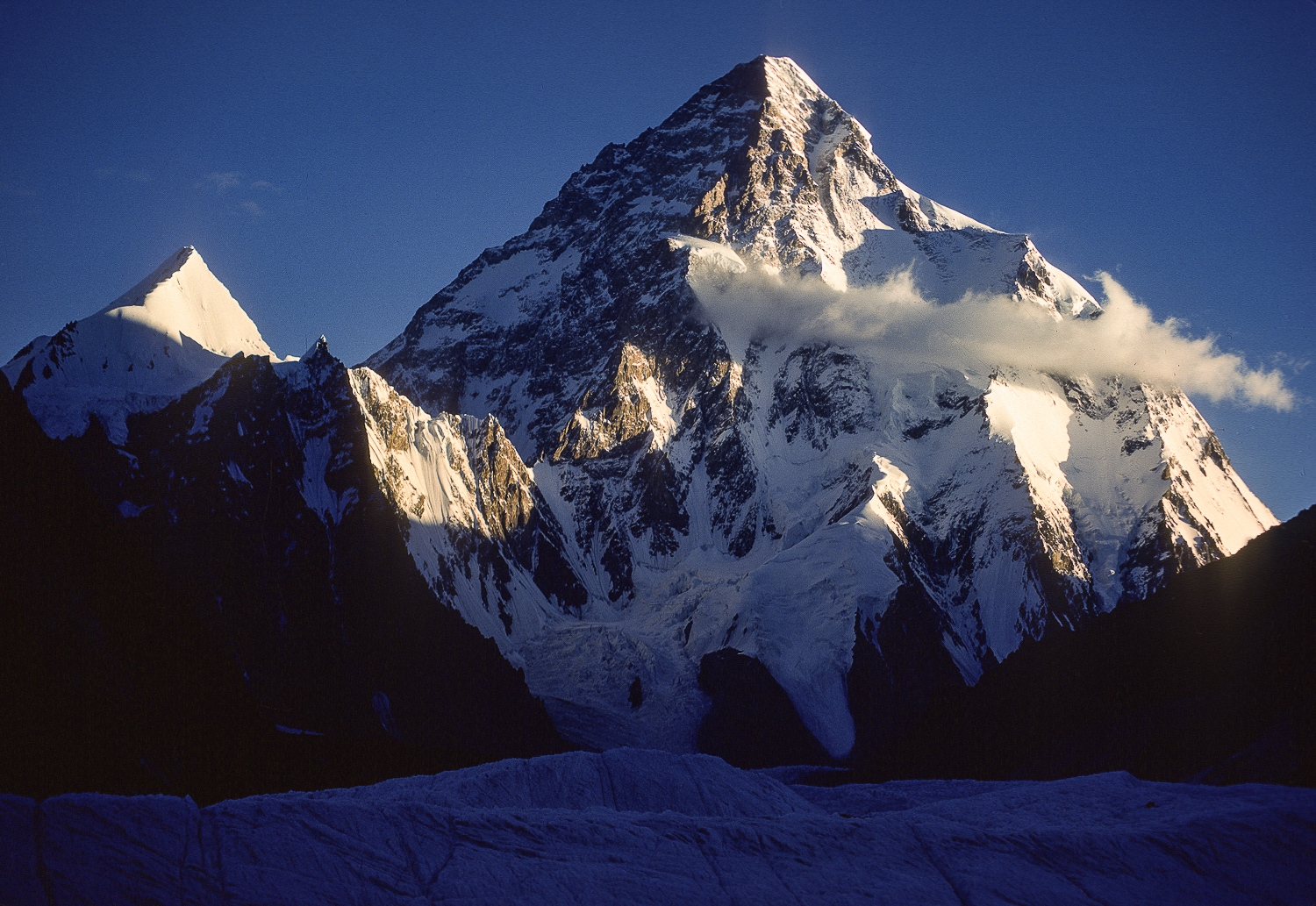K2, called locally Dapsang or Chogori and dubbed the Savage Mountain, is the world’s second highest peak—bested by only 779 feet by Mount Everest. Towering 28,251 feet along the Pakistan-China border in the Karakoram range, the peak is known for its incredible steepness, technical difficulty, avalanche danger and quickly changing weather conditions.
“Climbers pretty universally consider it the most dangerous of the 8,000-meter peaks,” said Rick Ridgeway, one of the Americans who summited the mountain without oxygen in 1978. “It was a good thing we didn’t know that then.”
On Sept. 6 and 7, 1978, a 14-person team worked together to get four members to the summit, becoming the first Americans and third team in history to do so. Forty years later, it remains among the most notable achievements in American mountaineering history. And thanks to never-before-seen photography shared by expedition photographer Dianne Roberts at a Mountaineers celebration of the anniversary, attendees were recently able to look back with new eyes. During the celebration, most of the team reminisced about the climb—remembering the difficulties, the sense of achievement and the way they worked together to finally top the treacherous mountain.
Led by famed climber Jim Whittaker, the first American to summit Everest, the team consisted of a mostly Seattle-based group: Craig Anderson, Cherie Bech, Terry Bech, Chris Chandler, Albert “Skip” Edmonds, Diana Jagersky, Louis Reichardt, Rick Ridgeway, Dianne Roberts, John Roskelley, Robert Schaller, Bill Sumner, Jim Whittaker and Jim Wickwire. Whittaker was CEO of REI at the time and earned both a four-month leave of absence and thousands of dollars of gear for the expedition.
Oscar Eckenstein was the first person to attempt the mountain with an international expedition in 1902. The first successful K2 summit was achieved by an Italian expedition comprised of scientists in 1954. By 1978, four U.S. expeditions had failed to reach the summit, the first in 1938. According to high-altitude climber and author Steve Swenson, some began calling it the American mountain, due to the multiple failed attempts. “It was like going on hallowed ground,” said Wickwire, a Seattle attorney and among the four Americans to summit in 1978. “Climbers climb on the shoulders of their predecessors.”
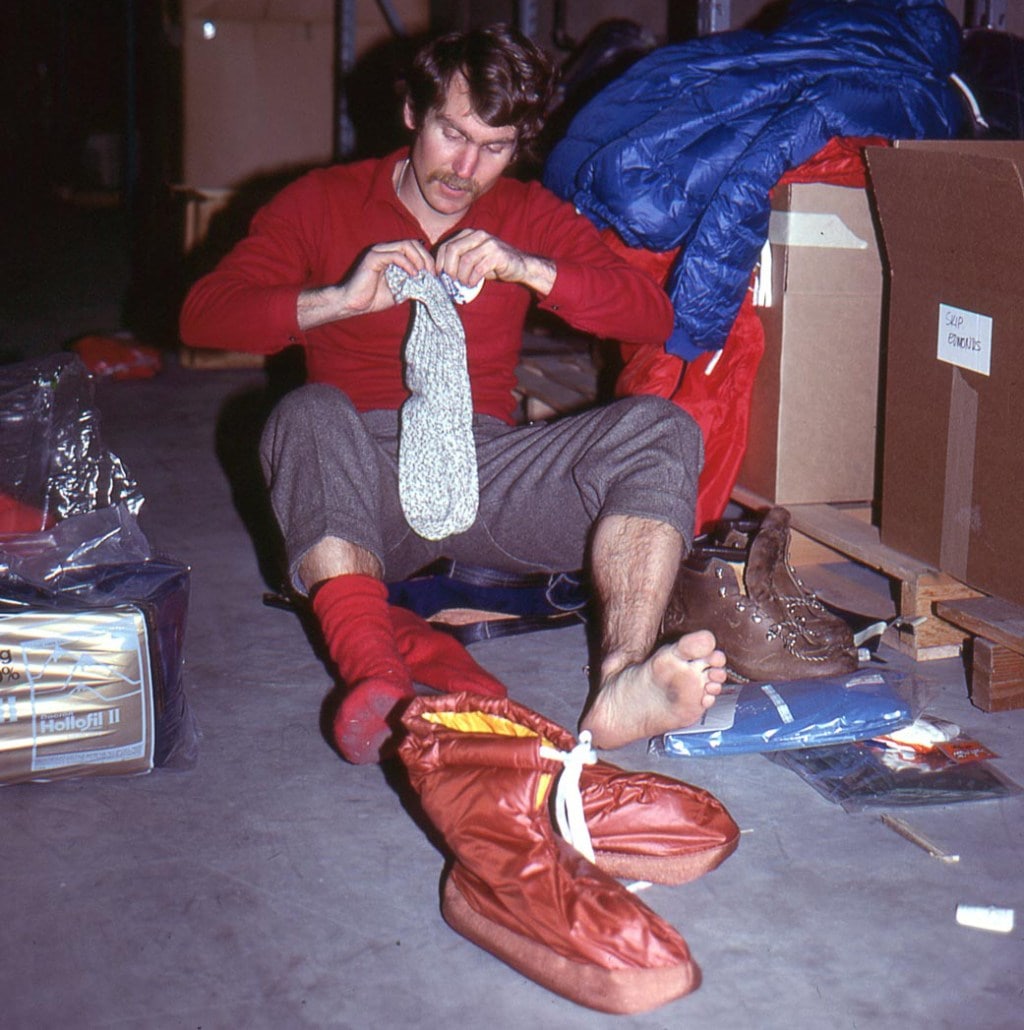
Team member Skip Edmonds getting ready for the expedition in the REI Distribution Center. Photo Credit: Bill Sumner
In 1975, Whittaker led his first K2 expedition, but weather, illness and an impassable route shut the team down and they turned around at 22,000 feet. “It kind of festered,” Whittaker said in a recent interview. During the ’78 expedition, the porters made it to basecamp in 13 and a half days, nearly half the time taken in ’75, perhaps in part due to the 100 pairs of Vibram-soled shoes the expedition team brought along for the purpose (the previous porters had been barefoot). The porters marched forward—a few even carrying loads up the mountain as high as Camp 3, at 22,300 feet.
But the team’s luck didn’t hold out. They faced nine storms in quick succession, forcing them to establish and reestablish camps. “We were freezing half the time, too hot the rest of the time,” said Roskelley, another summiter and recent recipient of the American Alpine Club’s Honorary Membership, one of the highest awards the AAC offers. “At any time one of us could make a mistake and plunge thousands of feet.”
There were personality clashes too. “I want to be really honest about the challenge,” Ridgeway said. “Overcoming not just the difficulty of the mountain, but our own competing desires and dreams.”
But they continued moving farther up the mountain. Between Camps 3 and 4, Ridgeway recalls, “[I] was at a station belaying John [Roskelley] in really steep snow and ice. My mind was drifting, all of a sudden I popped into more of a focus, because there was a butterfly on the snow around me,” said Ridgeway. Suddenly, “you couldn’t close your door fast enough. They were in the pots and clothing,” Roskelley said. Ridgeway and Roskelley said they found out, 40 years later, that this was the highest-altitude sighting of free-flying butterflies ever recorded, per James Bergdahl of the Conservation Biology Center. Roskelley was able to take color photos of them on the tent at Camp 3. The mountaineers had witnessed a painted lady migration.
Camp 5, at 25,300 feet, was established after three weeks of storms battering the expedition. It was there that Roberts and Cherie Bech set a high-altitude mark for American women. “If anything I did at that point in my life encourages women to get into the mountains, I’m happy to play that role, whether I intended to or not,” said Roberts, expedition photographer and Whittaker’s wife.
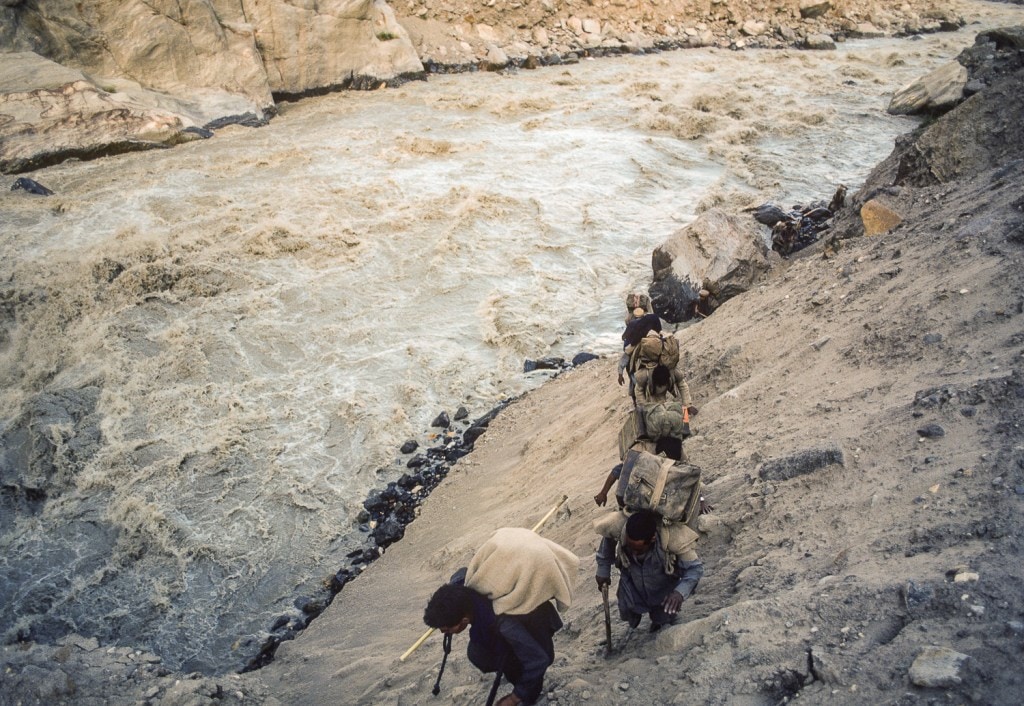
Porters along the Braldu River. Photo Credit: Dianne Roberts
In early September, the push for the summit began. Time was running out for the expedition: After weeks of storms, the team was worried about the weather window closing. The team had gotten word that the porters were trekking in to help carry loads out. It was now or never. Terrance and Cherie Bech, Reichardt, Ridgeway, Roskelley and Wickwire were all settled in Camp 5.
After much discussion, it was decided: Ridgeway and Roskelley would take on the direct Polish finish, originally attempted by a Polish team led by Jnnusz Kurczab in 1976, while Reichardt and Wickwire would traverse to the Abruzzi route, the path most often used to the summit, with the Bechs to support them.
On Sept. 3, when Reichardt and Wickwire set out, there was deep snow, but on the next day with better weather, they were able to establish Camp 6 at 25,800 feet. That’s when a series of mishaps threatened to take Wickwire’s life. First, he tipped a water pot over on his sleeping bag and down jacket, so he left them behind. Later, he dropped his only water bottle and was forced to watch it skitter down the slope out of sight.
Even so, Reichart and Wickwire decided to push on toward the summit on September 6. Reichardt had his own troubles. At around 26,500 feet, he decided to start using oxygen, until he realized there was a puncture in the hose, rendering it useless. He pushed on without it and became the first person to summit K2 without supplemental oxygen.
Climbing past the infamous Bottleneck, a tower of ice and snow that regularly sloughs offs deadly discharges onto the climbing path (making it the site of many of the fatalities on the mountain), there was a long slog, with snow reaching their thighs. Eventually Reichardt decided to unrope to move across snow he felt was safer. After noticing this, Wickwire untied his end of the rope and they continued to the summit together. Daylight was running out and Reichardt, without supplemental oxygen, was terribly cold.
“Finally we [got] about 600 feet below the summit,” said Wickwire. “I thought about my family, my wife Mary Lou and my kids, something to take your mind off the monotony.”
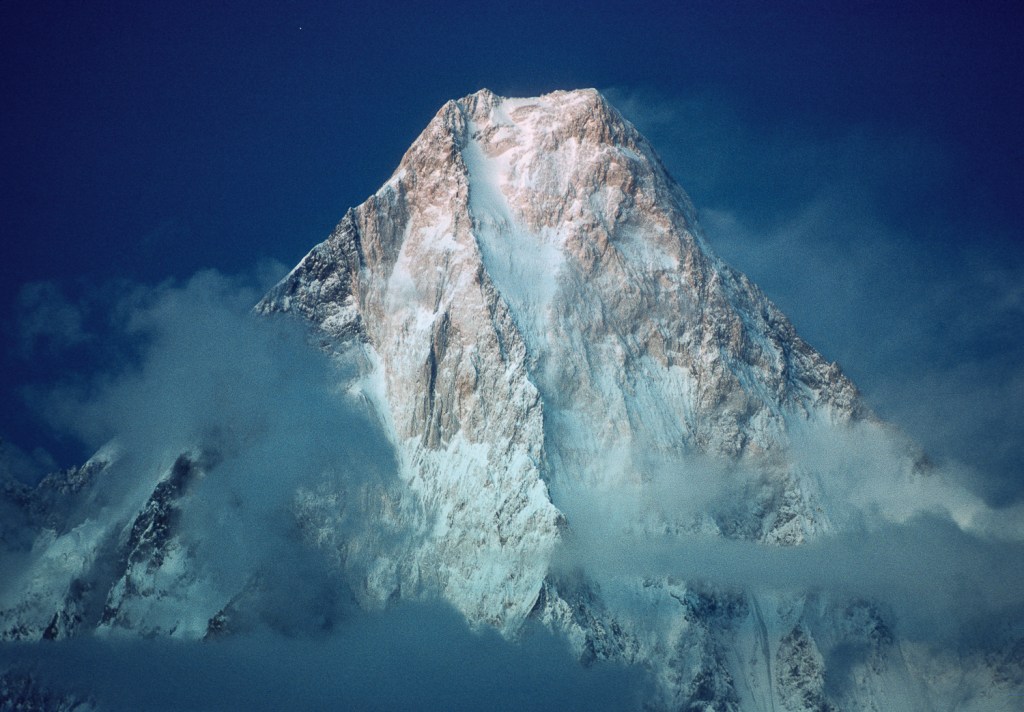
Gasherbrum IV in moonlight. Photo Credit: Dianne Roberts
They reached the summit together, taking a few pictures before Reichardt decided it was time to go down. That’s when Wickwire made his third mistake: to change the film in his camera. In 25-degree-below temperatures, he says it took him nearly 20 minutes to change the film. When he left the summit, half an hour behind Reichardt, twilight was settling around him. Wickwire, without a headlamp, realized it was too dangerous to continue down after Reichardt in the growing darkness.
That night, Wickwire unintentionally set a record for one of history’s highest bivouacs. At first, Wickwire says, he felt relatively warm in his bivvy sack. But soon, he ran out of supplemental oxygen and fuel for his stove. He quickly became hypoxic and cold. The climbers below, realizing he would have to spend the night so high on the mountain, were worried. “Fear was going through my mind that Wickwire was dead,” said Sumner, watching the mountain from Camp 1 that night. “By all statistics he shouldn’t have made it through the night or come down all that way by himself over that technical terrain without anybody helping him.”
“All I’ll say about the night,” Wickwire said, “is it was long and cold.”
The next morning, September 7, Ridgeway and Roskelley started up the mountain. “At that time we thought we were on a rescue mission as much as a summit attempt,” Ridgeway said. The day before they were working their way up the Polish finish, but the avalanche danger was so bad, they decided it was too dangerous and switched to the Abruzzi route.
“We didn’t really know if we would be able to traverse around successfully,” Ridgeway said. “Looking back on it, I feel as good about turning back on the direct route as I do about succeeding in going around.”
They climbed, the way made a little easier by Reichardt and Wickwire’s path through the deep snow. They passed under the deadly Bottleneck and, “there in the middle of a cloud was this apparition standing, and it was Wick,” Ridgeway said.
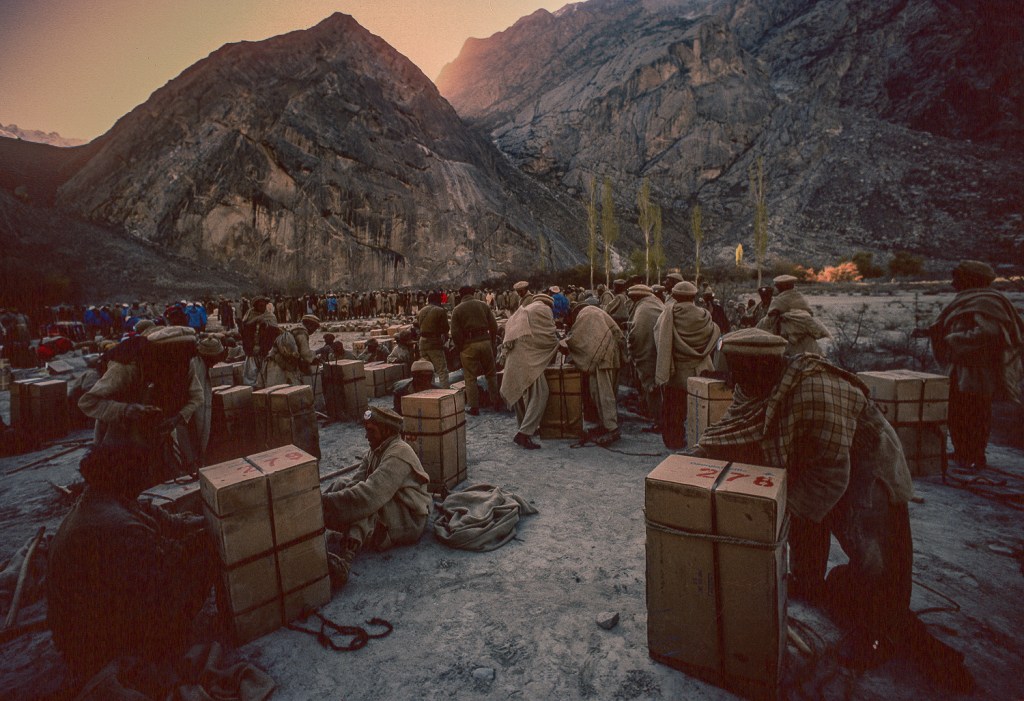
Porters from the 1975 expedition. Photo Credit: Dianne Roberts
Wickwire insisted that he was fine to make his own way down the mountain. After talking with Wickwire for a few moments, Ridgeway and Roskelley continued toward the summit. “John [Roskelley] was a stronger climber than me, always mentally pulling me on. I had to be able to do it because John was going to do it,” Ridgeway said.
“We were unroped, 27,000 feet up on technical ground. I remember [it] required razor focus on every move that you were making,” Ridgeway said. “I remember looking at my feet as I was pointing holds on the rock, seeing the glacier right below me, 12,000 feet down. Seeing the skill with which John traversed that was inspirational. It was one of the reasons I was able to get up and down without killing myself.”
At 28,000 feet, Ridgeway said he reached a wall, like what a marathoner reaches near the end. “I found it was nearly impossible to continue on,” he said. “I also began to hallucinate. I saw palm trees growing out of the snow. There were visions of Tahiti and sandy beaches. Voices telling me I should turn around and go back. That I was risking my neck.”
Through it all, they continued skyward. At last they put their arms around each other, arriving at the top of the second-tallest mountain together. They spent a few moments savoring the summit.
But it wasn’t over. They had to get down safely, too. “We both had to be very, very careful,” Ridgeway said. “In the back of your head, the real work is starting right now.”
Wickwire and Ridgeway speak about their experience on K2.
Ridgeway and Roskelley descended carefully, finding their way to Camp 6, where Reichardt and Wickwire were already camped. Once settled in their tent, Ridgeway and Reichardt accidentally blew up their stove by changing a fuel cartridge while another stove was burning. This set Ridgeway’s sleeping bag on fire and caused the four men to have to spend the night in a single tent, miserable.
The entire team finally made it down the mountain to advanced basecamp. “The happiest moment in the trip was to see everyone coming back into basecamp,” said Sumner, a member of the team and physicist. “First, everyone could get back, and [second], we [could] go home now. I’d had quite enough.”
Schaller, one of the doctors on the trip, discovered Wickwire had pneumonia, pleurisy and blood clots in his lungs. Porters carried Wickwire for a time until he was sick of the jostling and walked his way down the glacier. It was September 17 when two Pakistani military helicopters took Reichardt, Roskelley, Schaller and Wickwire off the mountain. The 10 other members of the expedition were forced to walk more than 100 miles before heading home.
“Climbing K2 revealed what it means to be human,” said Terrance Bech, climber, musician and anthropologist. “It’s an accomplishment, showing that we grasped our place in the universe. It’s an example of what we can achieve together.”
